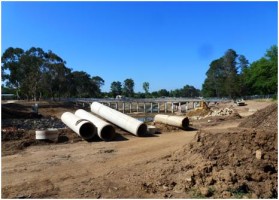Widgetized Section
Go to Admin » Appearance » Widgets » and move Gabfire Widget: Social into that MastheadOverlay zone
Protecting The Public Interest
Highway Public-Private Partnerships
The views expressed are those of the author and do not necessarily reflect the views of ASPA as an organization.
By Michael Oyakojo
May 1, 2015
 Efficient and reliable public infrastructure is a necessity for growth and sustainable development. The astronomical increase in population, the effect of globalization and expanded economic activities has increased the demand for quality and reliable infrastructure.
Efficient and reliable public infrastructure is a necessity for growth and sustainable development. The astronomical increase in population, the effect of globalization and expanded economic activities has increased the demand for quality and reliable infrastructure.
Many governments and policy makers have adopted public-private partnerships (P3) as an alternative financing strategy to address the funding gaps for public infrastructure. Private investors inject fresh capital (a combination of equity and debt) for the upgrade of existing assets and or the construction of new infrastructure projects that would have been otherwise abandoned. Private operators have specialized expertise, sound project management skills, unique innovation and technology to deliver projects in a timely manner and maintain a high quality level. Despite these benefits, P3 have enormous risks and concerns that could undermine public interest.
The long-term duration of P3 lease and concession agreements connote the loss of public control of the contract. This is worsened by non-compete clauses which make future flexibility and infrastructure planning difficult. For instance, the Indiana’s Toll Road lease is for 75 years and the duration for the Chicago Skyway contract is 99 years. In several instances, public officials lack sufficient expertise and experience to negotiate, draft, review and execute of P3 transactions which could undermine the long-term interest of the public.
The diversion and use of “wind fall” revenues and upfront payments generated from the lease of existing assets for non-transportation needs inhibit infrastructure development. For example, a significant proportion of the $1.8 billion upfront payments generated from the Chicago Skyway transaction were diverted due to budget deficit and other non-transportation fiscal issues.
The United States Government Accountability Office revealed that privately tolled highways could charge higher tolls compared to publicly operated roads. The profit motive of private investors and the higher financing costs from debts make it imperative to charge an appropriate toll to recoup costs and earn a reasonable return on investments. Furthermore, the lack of transparency and the likelihood of corruption in the process of negotiating, reviewing, awarding and executing of P3 contracts lower public confidence in government’s dealings on these type of transactions.
In view of the above challenges, it is imperative that mitigating controls be put in place to address public concerns for successful P3. First, P3 contracts and agreements should have a relatively “comfortable duration,” with mandatory buyback provisions for future flexibility. In Professor Beverly Bunch’s case study on Texas, the state’s statute restricts the tenor of recent P3 arrangements to a maximum of 50 years with two years of moratorium. This “comfortable duration” is sufficient for private operators to recoup their costs and earn a reasonable return on investments without unduly tying the hands of the public.
Higher tolls and public subsidy could be necessary for shorter lease duration. The inclusion of non-compete and mandatory buyback (at an agreed price) provisions in the contracts allow flexibility for government and strategic planning needs. However, private operators could be compensated for shortfall in revenue from competing highways except roads for public safety and required by law.
Second, increased training and use of consultants and financial advisers would strengthen the public sector’s knowledge and expertise on P3 transactions for optimal public benefits. Due diligence should be conducted before the final selection of professional consultants to avoid conflict of interest on similar and or related transactions.
There is an urgent need for state laws and policies on the collection and the use of revenues generated from lease related to existing assets. Instead of the one-off, upfront payment, revenues could be shared over the duration of the contract. The proceeds from existing assets should be restricted to and invested in long-term public transportation projects. This would enhance productive and efficient funds utilization and prevent the use of long term funds to address short-term recurrent needs.
Additionally, adequate public disclosure and control systems are expedient for equity, fairness, accountability, transparency and elimination of potentially corrupt practices. Public hearings and broad consultation of stakeholders should be encouraged before entering into P3 contracts and at critical milestones of the projects. Zero tolerance on conflicts of interests and the prohibition of gifts should be enforced to promote ethical practices and professionalism for successful P3 execution.
In conclusion, P3 has proven to be a viable alternative and innovative strategy for the development of public infrastructure. The private operators invest in public infrastructure, in return for a reasonable profit, and the public sector receives a social service. It is imperative to balance these two divergent but important objectives for successful P3 implementation.
Author: Michael Oyakojo is an economist, chartered accountant, structured financier and policy analyst with experience in private and public sectors on three continents. He can be reached at: [email protected].


Follow Us!